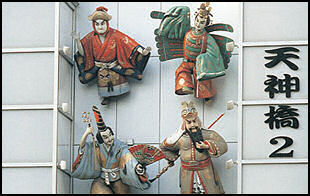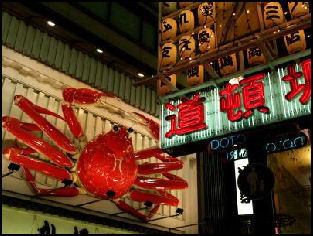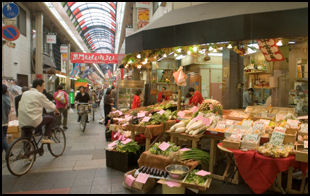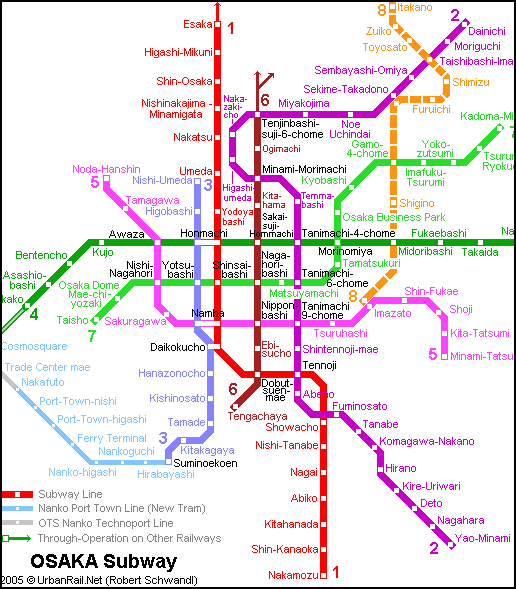OSAKA TOURIST INFORMATION

Tenjimbashi shopping area Osaka City has three main tourist information centers: at three city’s large train stations: 1) Umeda-Osaka Station, 2) Namba and 3) Shin-Osaka. The main one is located at Osaka (Umeda) train station at 3-1-1 Umeda, Kita-ku, Osaka, ☎ (06)-345-2189. The Kansai region also has tourist offices in Osaka, namely at Kansai Airport. There is also a tourist information Kansai and Osaka airports.
At these tourist offices you will find a wide range of maps and pamphlets about all attractions and facilities in Osaka City. At the tourist offices it is worth getting copies of the Guide to Osaka, the Osaka Sightseeing Map, information with a list of festivals and events and maps of both the Osaka subway and the Kansai area train systems. Staff members at the tourist offices are fluent in English and other foreign languages. In addition, however, there is a wealth of information available online. All you need to do is access one of the two free Wi-Fi connections available to visitors in the Osaka area: Osaka Free Wi-Fi and Osaka Free Wi-Fi Lite. The former offers you unlimited internet access while the latter allows you to use the internet 8 times a day for 30 minutes each (or for one hour in total). For more information on Osaka Free Wi-Fi, please see the Wifi and Rally. Websites: Osaka Convention and Tourism Bureau osaka-info.jp/en ; Osaka City Site Osaka City Tourism ; Wikipedia Wikipedia ; Wikitravel Wikitravel ;
See Separate Articles: OSAKA: ITS HISTORY, PEOPLE AND ECONOMY factsanddetails.com ; OSAKA DISTRICTS AND ENTERTAINMENT AREAS factsanddetails.com ; OSAKA SIGHTS: OSAKA'S CASTLE AND AQUARIUM, TEMPLES AND KOFUN factsanddetails.com ; INTERESTING MUSEUMS AND FACTORY TOURS IN OSAKA factsanddetails.com ; OSAKA THEME PARKS AND AMUSEMENTS factsanddetails.com
Umeda-Osaka Station Tourist Information Office
North Central Gate, 1st fl., JR Osaka Station, 3-1-1, Umeda, Kita-ku, Osaka City, Osaka Pref. Tel. 06-6345-2189;
Hours Open: 8:00am-8:00pm Closed on December 31-January 3;
Website: osaka-info.jp/en
Namba Station Osaka Visitors' Information Center
5-1-60, Namba, Chuo-ku, Osaka City, Osaka Pref, Tel. 06-6631-9100;
Hours Open: 9:00am-8:00pm Closed on December 31-January 3
Website: osaka-info.jp
Tourist Information Shin-osaka
In the Travel Service Center Shin-osaka
Jr Shin-osaka Station 3rd Floor Concourse
Hours Open: 8:00am to 10:00 pm
Kansai International Airport Kansai Tourist Information Center
Kansai International Airport Passenger Terminal Bldg., Osaka Pref.,Tel. 072-456-6025
Hours Open: 7:00am-8:30pm
Osaka Tourist Infomation Center
Shinsaibashi OPA Main Bldg. 8F
Hours Open: 9:00am to 9:00pm. Open all year round
Kansai Tourist Information Center Daimaru Shinsaibashi
Daimaru Shinsaibashi (Daimaru Shinsaibashi Store South Bldg. 2f)
Hours Open: 10:30am to 9:00pm. closed January 1
Osaka Tourist Information Center
2F Daimaru Shinsaibashi South Tower, 1-7 Shinsaibashisuji Chuo-ku, Osaka City, Osaka Pref., Tel. 06-6625-2021
Hours Open: 10:00am-8:30pm, Closed on January 1
Orientation and Layout of Osaka
Osaka is broken up into districts and shopping and entertainment quarters like Umeda, Namba, Abiko and Tennoji, most of which can be reached by subway stations with same name. The heart of Osaka is divided into Kita (the northern end) and Minami (the southern end). Midosuju is regarded as Osaka’s main street. It connects Umeda district in the north with Namba in the south, Umeda and Namba are Osaka’s main entertainment, shopping and eating areas.
Like Tokyo, Osaka is very confusing. The map for the Osaka subway and train system looks like a wiring diagram for a super computer, most small streets have no name, buildings are numbered according to age, addresses refer to a series of concentric areas and taxi drivers respond to landmarks not street numbers. Before setting out anywhere it is a good idea to have detailed directions and a good map in English and Japanese. Most stores and restaurants can fax or e-mail a good map to your hotel if you call them in advance.
Maps : Official Osaka Site osaka-info.jp/en/page/area-map ; Maps of the World mapsofworld.com ;Joho Maps Joho Maps ; Areas of Osaka Maps : Central Osaka s3-ap-northeast-1.amazonaws.com Osaka Castle Map: Osaka Castle site osakacastle.net Tennoji, Abeno, Namba Map: s3-ap-northeast-1.amazonaws.com Osaka Bay Area Map: s3-ap-northeast-1.amazonaws.com Train Map : s3-ap-northeast-1.amazonaws.com
Entertainment in Osaka

Shinsaibashi The best source of entertainment information was Kansai Time Out but it ceased publication in September 2009. Time Out continues to exist online and remains a good source. Entertainment guides and calendar of events may be obtained from the tourist offices, hotels with foreign customers and newsstands. You can also check out local Thursday or Friday weekend entertainment supplements in the English newspapers (Japan Times and Japan News), the Lonely Planet books, other guidebooks, and posters put up around town. Entertainment Websites: Osaka Official Site osaka-info.jp ; Osaka Time Out osakanightlife101.net
Movie houses throughout Osaka show first-run American, Japanese and foreign films, but the prices are double that of the American. Concert halls and other venues offer concerts by world-famous classical and international pop stars as well as symphony orchestras, ballet, and opera. Symphony Hall and Izumi Hall are the two main concrete halls in Osaka. Classical music, pop music events and traditional forms of Japanese music and dance are also hosted at various venues in Osaka. The America Mura and Yorappa Mura districts in Osaka are places where young Japanese come to be seen and check out the latest fashions and trends.
Bunraku puppet theater can be seen at the National Bunraku Theater of Japan in Minami. Tickets are generally around $35 to $50. A few years English interpreation was provided through earphones. Kabuki is performed at the Shin Kabukiza Theater. Noh and kyogen are performed at the Osaka No Kaikan. Sochiku-za Theater sometimes host kabuki performances. You can also go to Kyoto for kabuki and noh.
Takarazuka Grand Theater (30-minute train ride from Kobe, a little longer from Osaka) is the home of the famous Takarazuka all-women revue. Takarazuka is an Osaka suburb. The Takarazuka Grand Theater holds 3,000 people. The shows are musical adaptions of Japanese and foreign stories and operas. The audience is almost entirely made up of Japanese women.There is a constantly changing bill.
Apollo (near Sakuragawa Station in the Sennichimae subway line) was one of Japan most famous show pubs. It still exists but now is mainly a multiplex cinema area with a game and shopping area. It was a six-story establishment with a different theme on each floor that charged customers ¥9,000 for a visit to a single floor or ¥25,000 for a tour of all six. The prices includes free drinks and snack. On the second floor, in the Pink Daiya, the women were topless. In the Pink Poodle on the top floor, they were naked except for sheet lingerie. On the first floor al the girls had dyed brown hair or wore platinum blonde wigs. Customers spent most of their time chatting with the hostesses as they would in a hostess bar. On the second floor customers could play rock-scissors-paper games with topless waitresses. Winners got to touch the tits. For a tips sometimes the waitresses put their tits in a customer’s face. Many girls at the Apollo said they liked working there because there were strict rule as to when customers were allowed to touch and when they aren't.
Entertainment Areas in Osaka
The main shopping and entertainment districts are Umeda (in Kita), Namba (in Minami), Dotonbori (part of Namba) and to a lesser extent Tennoji. These areas also have a lot of nightclubs, bars, pubs, restaurants, cinemas and theaters. Soemoncho and Hozenjiyokoncho are areas within Namba that have a lot of restaurants and bars. Shinsaibashi, across the Dotombori River, is an extension of the Namba entertainment area.
Street musicians play on the pedestrian bridge in front of Hankyu Railway's Umeda Station and the adjoining JR Osaka Station. Acts that have appeared here have included a jazz quartet, a three piece rock band, a homeless female dancer, a violin-guitar duo, and a pair of young girls that play ukeleles and sing Hawaiian songs. The Hankyu Fortune-Telling Center, below the elevated rail lines of Hankyu Umeda Station, is a center of Osaka fortunetelling.
See Separate Article OSAKA DISTRICTS AND ENTERTAINMENT AREAS factsanddetails.com
Sports and Amusement Parks in Osaka

Kyocera Dome The spring sumo tournament is held in Osaka in March.Spectator events are held at the UFO-like Osaka Dome and the stadium and sports area in Naga and other stadiums and arenas around town. Osaka’s beloved Hanshin Tigers baseball team plays at Koshein stadium between Osaka and Kobe. There are amusement parks with lots of twisting high-tech roller coasters and scary rides at Hirapa (Hirakata Park), and Simland Q. Expoland was closed after people were killed a derailed roller coaster. Universal Studios Below.
The Maishima Sports Island, a manmade island off the northern port of Osaka, with some interesting recreation areas. Fukuyama Bowl (Osaka) is the world's largest bowling center, with 156 lanes. Joyopolis has a branch in Umeda. It is a huge arcade operated by Sega with life-size versions of its video games along with virtual reality white water rafting, skateboarding, searching for treasures and fighting monsters in a medieval castle. In one ride you and six other people cruise around in a submarine and shoot at giant octopuses and other creatures with an electric gun.
Restaurants in Osaka
In the opinion of many Osaka has the best food in Japan and there are tens of thousands of restaurants in the city, offering a variety of Japanese foods, as well as cuisine from China, France, Italy, Thailand, India, and many other countries. There are also a large number of American fast food restaurants such as McDonalds, Pizza Hut and Kentucky Fried Chicken, numerous cafes and coffee shops, and a Hard Rock Café.
A good list of restaurants is sometimes available from the tourist office and restaurant guides are sometimes on sale at bookstores and newsstands. You can also check lists of restaurants and suggestions in Time Out, other local entertainment magazines, the Lonely Planet books, and other guidebooks.
“The Michelin Guide Kyoto and Osaka 2010" was released in October 2008. Six restaurants in Kyoto and one in Osaka were awarded three stars. They included 400-year-old Japanese restaurant Hyotei, the main restaurant in Arashiyama of Kyoto Kitcho and the French restaurant Hajime in Osaka. In the guide the five level rating system was applied to restaurant and ryokan.

There are many good eating area in and around Umeda (in Kita), Namba (in Minami), Dotonbori (part of Namba) and to a lesser extent Tennoji. There is a particularly good selection of cheap restaurant in the underground shopping centers and covered shopping streets at Umeda, and the streets in Minami south of Nagahori-dori around Osaka Tower. Osaka has a large Koreatown with a lot of Korean restaurants.
There are a lot of good Japanese pancake restaurants, sushi bars, indoor yakitori bars, bakeries, and Chinese restaurants scattered all over Osaka. There are good deals where restaurants are grouped together and offer special deals to be competitive. Soemoncho (in Namba) is famous for its high class restaurants. Hozenjiyokoncho (also in Namba) has many small restaurants and bars. The restaurants at the hotels tend to be overpriced. There are many good, cheap grilled meat restaurants around the Korean Market (near Tsuruhashi Station on the JR Loop Line).
Osaka has the second largest fish market in Japan but visitors are generally not welcome. There are some sushi and seafood restaurants around it.
Restaurant Websites: Osaka Convention and Tourism Bureau Osaka Info Kansai Restaurant Guide Bento.com ;
Shopping in Osaka

Kuromen Ichiba market Osaka people have a reputation for bargaining everywhere even at the department stores. One 37-year-old housewife told the New York Times, “I usually haggle when I go shopping...I negotiate prices, even in large stores. We haggle while smiling and tricking each other, and we make them give us discounts. If you live in Osaka, you’ll do it. It’s something you’re born with here.”
Bargaining and haggling are not as common as it once was, especially since the recession closed many mom and pop stores, leaving behind Tokyo chains that don’t tolerate it. One Osaka shop owner told the New York Times, “In Tokyo, I understand people don’t want to haggle over prices because they think it’s not cool. They check prices from place to place before actually buying anything. Ths Tokyo style is spreading to Osaka.”
The main shopping and entertainment districts are Umeda (in Kita), Namba (in Minami), Dotonbori (part of Namba) and to a lesser extent Tennoji. The Shinsaibashi Shopping Street (the busiest in Osaka, with department stores on one side and many old established shops on the other) is across the Dotombori River from Namba. Osaka Amenity Park (OAP), near the Imperial Hotel Osaka has many upscale European designer shops. There is a shopping area at Kansai Airport.
Den-Den Town is the largest electrical appliance shopping district. It is filled with shops with the latest digital camera, computer and video games, robots and electronic gizmos. The stores have names like Fanatic Computer and Scoopland. One of the largest stores, Softmap, has different branch on different blocks.
Kuromon Market (Nipponbashi) is Osaka's busiest food market. Regarded as Kansai’s Kitchen, it contains more than 170 shops selling fish, dried seaweed, tofu, vegetables and fruit to restaurants as well normal shoppers. Many of the shops sell gourmet and high quality food items intended for fancy restaurants. About 18,000 people visit the market every day,
Doguya-Suji Market (near Namba Station) has numerous shops selling restaurant supplies and plastic food. Aburatani Koseido is particularly good place to shop for plastic food. The Korean Market (near Tsuruhashi Station on the JR Loop Line) contains more than 1.000 shops and stalls. It caters to Osaka’s large Korean community and offers a wide selection of kimchi, spices. Korean-style crabs, and other Korean food as well as stores with traditional Korean clothes and household items.
Shopping Website: Osaka Convention and Tourism Bureau Osaka Info Japan Visitor japanvisitor.com;
Whity Umeda is the largest underground shopping mall in Japan. Spreading out under three streets off Umeda, it is divided into 3 zones. All the concourses are lined with restaurants, boutiques and novelty shops. There are entire sections devoted to fashion dress shops, tea houses and bars. Nearby are the Hankyu, Hanshin and Daimaru department stores. West of Whity Umeda is Dia Mor Osaka, another large underground mall. The Big Man large screen television is a popular meeting place.
Hankyu Sambangai Shopping Arcade has rows of fashion shops on the first basement floor and a man-made river running along the second basement floor. Nearby is Trevi Plaza, named after a famous fountain in Rome, and the Hankyu Fire Building. Both are popular gathering places for young people. There is a relatively new shopping arcade in this area called the Petit Champs Élysées.
America Mura (Americatown) and Yorappa Mura around Tower Records in Shinsaibashi are places where young Japanese come to be seen and check out the latest fashions and trends. The area contains a large Tower Records, a popular Disney store, boutiques, used clothing stores, bars and restaurants. It has been estimated that 200,000 clothes-crazy young people descend here on the weekends.
Accommodation in Osaka
Osaka has quite a few deluxe hotels including a Hyatt and a Hilton. There are also quite a few standard hotels, hostels, and business hotels. Hotels are scattered all over town; some are located near the train main stations. The Minami (Namba) area and the Osaka Station (Umeda area) are the best places to look for business hotels.
There is a better selection of cheap hotels and hostels in Kyoto. Many people recommend staying in Kyoto and visiting Osaka by train. The English-language West Japan phone has a good list of hotels in Osaka, Kyoto and the entire Kansai area. "Hotels in Japan" from the Japan National Tourist Organization (given out at overseas tourist offices) has a good list of deluxe, luxury and standard hotels.
Hotel Websites: Osaka Convention and Tourism Bureau Osaka Info Osaka Hotels ihsadvantage.com ; Hotels Combined hotelscombined.com ;Japan Hotel & Ryokan Search jnto.go.jp/ja-search; Japan Hotel Association j-hotel.or.jp/en; Japan City Hotel Association jcha.or.jp ; Japanese Inn Group japaneseinngroup.com; Ryokan and Minshuku Japan Ryokan & Hotel Association ryokan.or.jp; Japanese Guest Houses Japanese Guest Houses Budget Accommodation: Japan Youth Hostels (click hostels for good map and description of hostels) Japan Youth Hostels; Check Lonely Planet books

Osaka subway map
Transportation in Osaka
Most people get around on the excellent but sometimes confusing 160-kilometer subway system. There are also numerous JR and local train lines (Hanshin, Nankai, Keihan, Hankyu and Kintensu), expensive taxis and buses without English signs. Train and subway fares are set according to distance, starting at around ¥140. In most cases the bus fare is around ¥260 for short inner city rides and more depending on the distance. Prepaid cards can be used for all city subways and buses. They come in ¥1,000, ¥2,000, ¥3,000, etc, denominations. Prepaid cards are also available for the city buses. Similar systems can be sued on the different local train lines. There are taxi stands at many railway stations, and taxis can also be hailed on the streets.
According to ASIRT: “Mass transportation is readily available. There is an extensive network of subways, privately owned light rail lines and the Japan Railway lines. Train stations are less than one mile apart. Bikes are not permitted on the trains. Has multi-story bike parking garages near suburban stations. Charge low fees. Subway routes are color coded. The system is generally well sign posted in Japanese and Romaji (the romanized version of Japanese). Buses are available, but most people use the subway or local train. Osaka’s flat terrain makes it ideal for cycling. Cycling is a primary means of transport for local residents. On-street parking is prohibited. [Source: Association for Safe International Road Travel (ASIRT)] ;
Subway and Train Maps: Osaka Metro Map: Urban Rail urbanrail.net; Joho Maps Joho Maps ; Train Map : s3-ap-northeast-1.amazonaws.com Osaka Tram Map: Urban Rail urbanrail.net Train Station: The main long-distance train stations are at Umeda and Tennoji. Shin Osaka is where you catch shinkansen (bullet trains) to Hiroshima and Kyushu in the south and Kyoto, Nagoya, Tokyo, Nagano, Yamagata, Niigata and Akita in the north. Osaka Station Map: osakastation.com
Tourism and Transport Passes for Osaka and Kansai
A special one-day ticket is available for ¥800 for travel on Osaka City subways and buses. One- and two-day tickets that can be used on all buses, trains and subways without limit cost around ¥2,200 for one day and about 65 percent more for two days. The prices are half for children. These tickets can be purchased online and at some subway stations, bus stations and bus and subway information centers. Websites: Pass Information osaka-info.jp/en ; Japan Guide japan-guide.com ; Osaka Convention and Tourism Bureau Osaka Info
Osaka Amazing Pass (for Osaka area) allows unlimited rides on Osaka City subways, Hanshin, Hankyu, Nankai, Keihan, Kintetsu lines as well as city buses. This pass entitles you to free o free admission to 28 tourist facilities including Osaka Castle and museums. You can also get discount at 13 popular spots and coupons at 37 places such as restaurants, shops, etc. Both one-day and two-day passes are available. The one day pass is 2,300 yen
Enjoy Eco Card is a special one-day unlimited card. You can use all Osaka Municipal subway and buses for free for one day. Plus, you will get a discount at sightseeing places in Osaka City for that day. 800 yen for adults (600 yen on weekends and national holidays) 300 yen for children You can use the ticket on the Osaka Metro and Osaka City buses but will not work on the Hanshin, Hankyu, Nankai, Keihan, Kintetsu and JR trains lines
Hankyu Tourist Pass gives you unlimited rides on the Hankyū rail network that connects Osaka with Kyoto and Kobe. If you want to explore all of these cities in a short space of time, the Hankyū Tourist Pass is a good choice .This pass is only available to foreign tourists visiting Japan for sightseeing with “temporary visitor”. You have to show your passport when you purchase the pass. The two-day pass may be used on non-consecutive days within its period of validity. When you purchase this pass, you will receive a booklet with special promotions for the Hankyū Tourist Pass holders. You can buy the Hankyū Tourist Pass at airports or at Hankyū Tourist Centers. One-day Pass:¥700; Two-day Pass:¥1,200, Website: kansai360.net
Kansai Thru Pass 2-day-3-day ticket is convenient and economical for traveling in Kansai. It allows you unlimited use of designated public transportation in Kansai. Also special treatment at selected facilities along the railways, made available by showing the pass you have used that day. The Kansai Thru Pass can be purchased at a travel agency before your visit, or after you arrive in Japan at the Tourist Information Center at Kansai International Airport. Two Day Pass: ¥ 4,300 for adults and ¥2,150 for children six thru 12. Three Day Pass: ¥5,300 for adults and ¥2,650 yen for children six thru 12.
Yokoso! Osaka Ticket provides a discount when traveling from Kansai International Airport Station into Osaka City, including a one-way ticket for the Nankai Electric Railway "Rapi:t" train to Namba Station (which can also be used one way on a Nankai train other than Rapi:t), and a one-day all-you-can-ride pass for Osaka's subways, the new tram, and buses. You can also enjoy Osaka's sightseeing spots at a discount, by showing a ticket that you've used that day for discounts at tourist sites within Osaka City. Price: ¥1,530.
Osaka 1 day and 2 day Passes are recommended for visitors who plan to travel around within the Osaka city center for a full day or more. It allows you unlimited rides on the Osaka Metro and Osaka City Buses . Also, by showing a pass that you've used that day, you can get special treatment at special facilities along the railways. A two-day pass is ¥3,600.
Osaka Kaiyu Ticket is a discount ticket set includes an admission ticket to the Osaka Aquarium Kaiyukan, as well as a one-day all-you-can-ride ticket for Osaka Metro, Osaka City Bus . Thirty tourist locations in the Osaka Bay area offer discounts of up to 50% off. Adult (high school students and above: ¥2,800; elementary-school-age children: ¥1,400.
Multiple Ride Card is a prepaid discount card which is valid for transportation on Osaka Metro, Osaka City Bus . No term of validity is set.
ICOCA is a convenient JR-West IC card for JR, Subways, private railways, and buses as well as in the PiTaPa area. You can pass through automated wicket gates without removing the card from its case.
JR West Rail Kansai Area Pass is a good deal for those who want to travel around Kansai for a full day or more, and is convenient for traveling to Osaka, Kyoto, Kobe, Himeji, or Nara, etc., via JR. It allows you to ride in the free seating section of the limited express Haruka from Kansai International Airport.One day: ¥2,400 for adults (12 and over); ¥1,200 for children (6-11): Two day: ¥4,800 for adults (12 and over); ¥2,400 for children (6-11): Three day: ¥5,800 for adults; ¥2,900 for children; Four day: ¥6,800 for adults; ¥3,400 for children
Image Sources: 1) Japanese Guest Houses 2) 4) 7) Wikipedia 3) Visualizing Culture, MIT Education 5) 6) 8) Osaka Visitor's Guide 7) Ray Kinnane 8) Osaka Visitor's Guide and Urban Rail
Text Sources: JNTO (Japan National Tourist Organization), Japan.org, Japan News, Japan Times, Yomiuri Shimbun, Japan Ministry of the Environment, UNESCO, Japan Guide website, Lonely Planet guides, New York Times, Washington Post, Los Angeles Times, National Geographic, The New Yorker, Bloomberg, Reuters, Associated Press, AFP, Compton's Encyclopedia and various books and other publications.
Updated in July 2020
